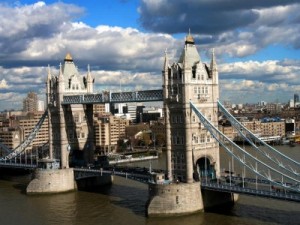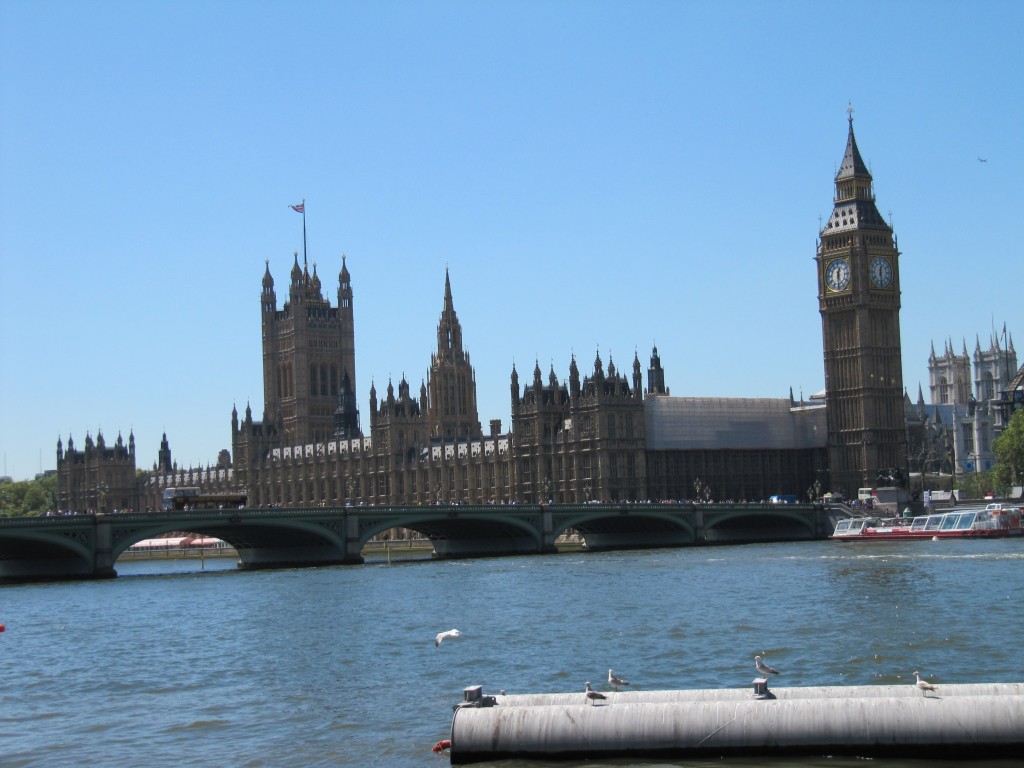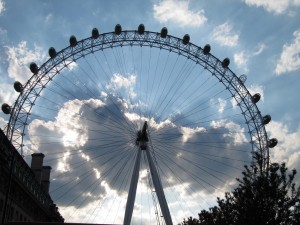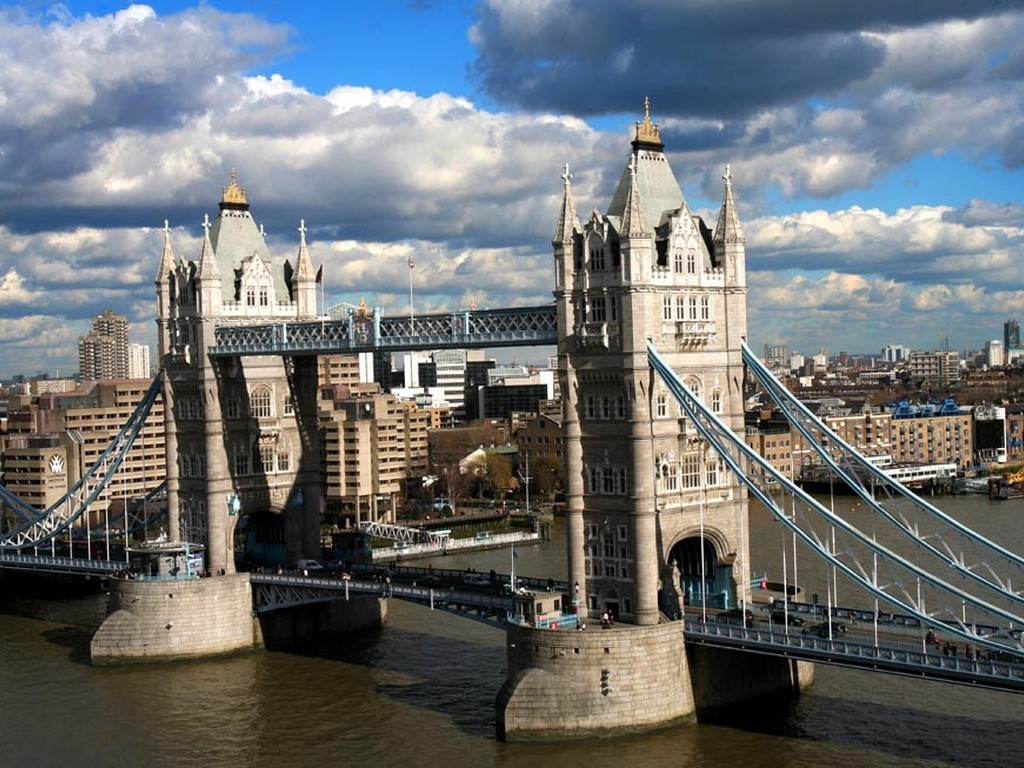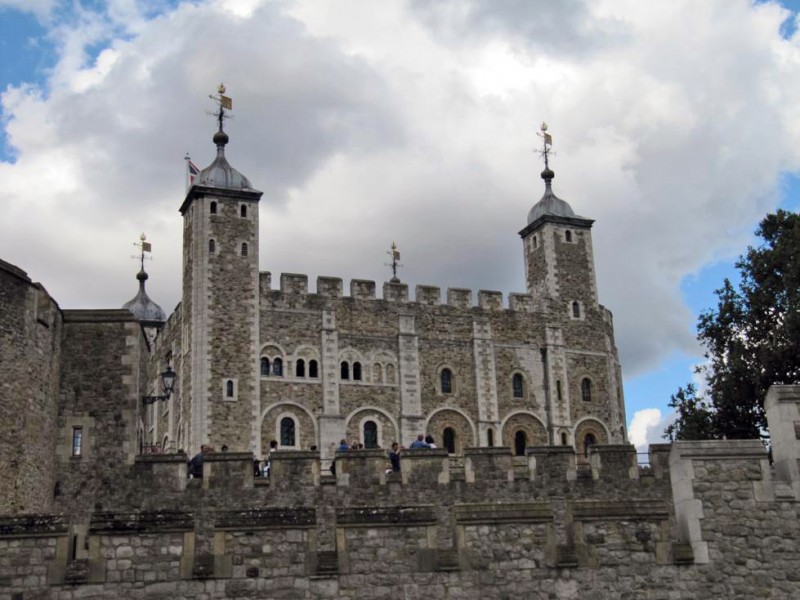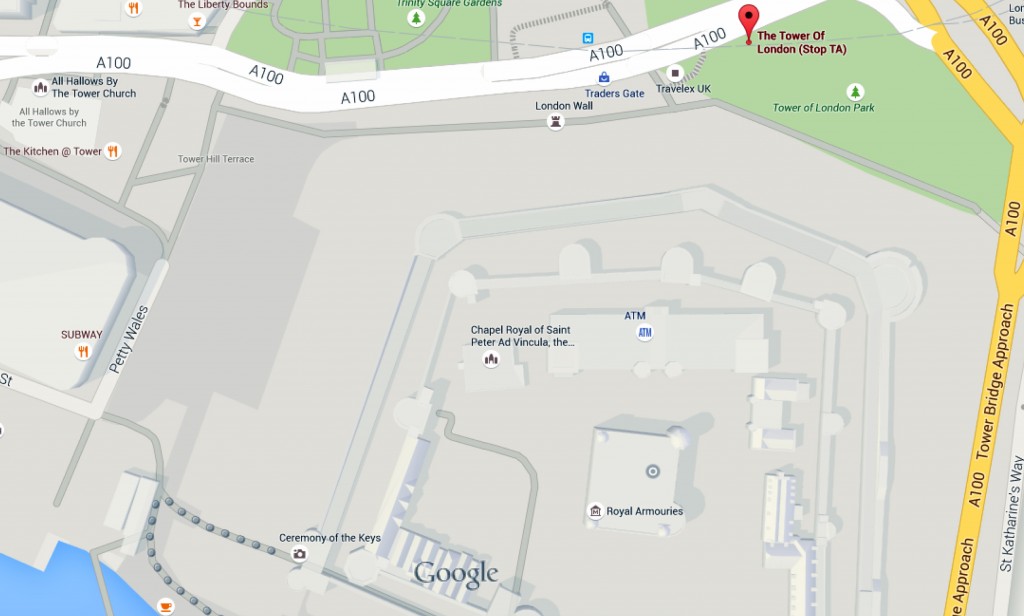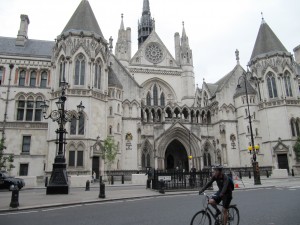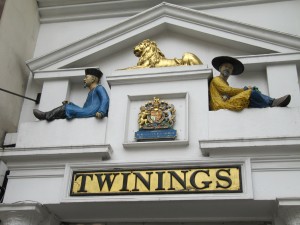From the London Eye to the Tower of London.
Distance: about 5 km.
Time: 1 hour 1/2
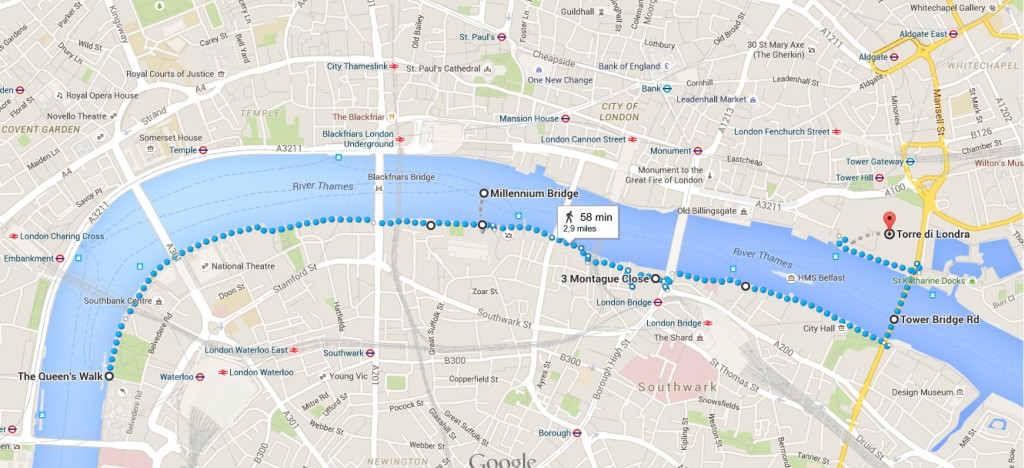
Many European capitals are crossed by a large river, but probably only London has been so much linked to it. Not only in ancient times, when the rivers were the cheapest and quickest means of transport, but even in more recently London has been depending on the Thames as a real source of wealth. Even today you can still see along the banks of the Thames the warehouses where goods from around the world were stocked. The Thames has made London a port and a trading city by nature, and it has been so for centuries. Nowadays, the areas around the river have been improved and modernized, and the old warehouses have been converted into luxury apartments, because living by the river is still fashionable and the views you can enjoy are just unique.
Even the Thames, which until a few years ago was considered biologically dead, underwent the same process of renewal, and now has returned to life, cleaned of centuries of indiscriminate urban and industrial pollution. Its banks, which were once unhealthy and dangerous places, today offer real walks without traffic, rich of colours, sights and stories to tell. And it is on these banks that we start our riverside London walk, which will also be a small journey through time and history.
Southbank
We start our London walk from Westminster Bridge, from where we can enjoy a wonderful view on Big Ben and the Houses of Parliament. Continuing along the south bank we will make our way through the crowd that comes to this side of the river to enjoy the local attractions: the Aquarium (Sea Life), the London Dungeons , the Adventures of Shrek and obviously the London Eye. We continue without stopping: even if some of these attractions can be fun, they are all quite expensive, and usually the queues are very long. However, if you cannot help it, I recommend to buy the tickets in advance: you will save some of the queues and you can even save money combining more tickets together. You can find all the information here.
- The London Eye has 32 capsules , numbered from 1 to 33. Why up to 33? Because there is no capsule n . 13, in case someone is superstitious.
- The capsules are 32 as the 32 boroughs of London.
- The rotation speed of the capsules is 26 cm. per second (just about the speed of a turtle). This allows you to enjoy the view in peace. After all that queue that you have done, you do not want it to end in a minute!!
After the London Eye, the number of people progressively diminishes. There will be several buskers and street jugglers until you reach the pedestrian bridge linking the two banks of the Thames.

Here the buildings are all pretty ugly: big concrete blocks typical of the architecture of ’60s, quite a contrast with the beautiful buildings on the other side of the river. The skateboard enthusiasts at least will be pleased to see that some of these horrible concrete underpasses have been transformed into a colorful and always crowded skate park, and even the least enthusiasts cannot avoid stopping to look at these kids showing their skills.
Here we also find the Southbank Centre, a cultural centre always full of events on the bill (and again it’s better to book in advance to avoid disappointment, if there is anything in particular you are interested in). There are also regular and seasonal events, such as the second-hand book market or the typical Christmas market. there is always something going on on Southbank!

We continue our walk along the Thames and we get to Waterloo Bridge. A little further on , on the right, we will find the lively Gabriel ‘s Wharf, a collection of independent shops and cafes. The place is of course more enjoyable in good weather , but it’s always worth to give it a try (even though the prices are not exactly cheap, like almost all establishments on the riverfront).
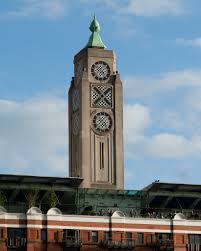
Other interesting shops can be found in the OXO Tower, an industrial building of the 30’s that has been completely renovated. Another example of how the south bank of the Thames was in the past , and how they managed to transform it and give it a new life.
Did you know? OXO is the trademark of a famous concentrated meat brand, which was invented by Justis von Liebig around 1840. OXO was the cheaper version which was launched in 1899. The first meat cubes were made in 1910 (before the product was liquid). In 1908 OXO was the sponsor of the Olympics and OXO cubes were part of the ration of the soldiers during the war.
Blackfriars
Continuing our walk we come across another bridge, Blackfriars Bridge, named after the Dominican monks who lived in the monastery on the other side of the river and were recognised for their black hooded cloak.
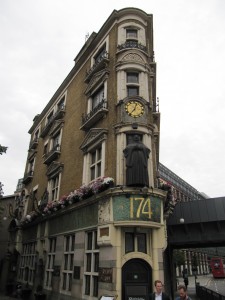
Did you know? The Dominican friars founded a monastery in the area today called Blackfriars in 1300. Having a lot of contacts with the rest of their order throughout Europe, the friars became gradually merchants. When they obtained permission to build a pier on the river for unloading the goods transported on the Thames, they became even richer, so much so that many of the properties outside the monastery belonged to them. With the dissolution of the monasteries in the sixteenth century, the Blackfriars lost all their properties, but the area is still identified by their name.
If you want to take a break for a beer, I suggest you to cross the bridge: on the right near the underground exit, you can see the Blackfriars Pub, built in 1906 in Art Nouveau style on the site formerly belonging to the Dominican friars. If you choose not to stop at the pub you can go straight ahead and after a short walk you will find yourself in front of the Tate Modern, the most important gallery of modern art in London (free admission). On your left you will see the pedestrian Millennium Bridge. For a beautiful view of the river, you should get at least the middle of the bridge, take your photos and return to the Tate (you can see St. Paul’s Cathedral on the way back).
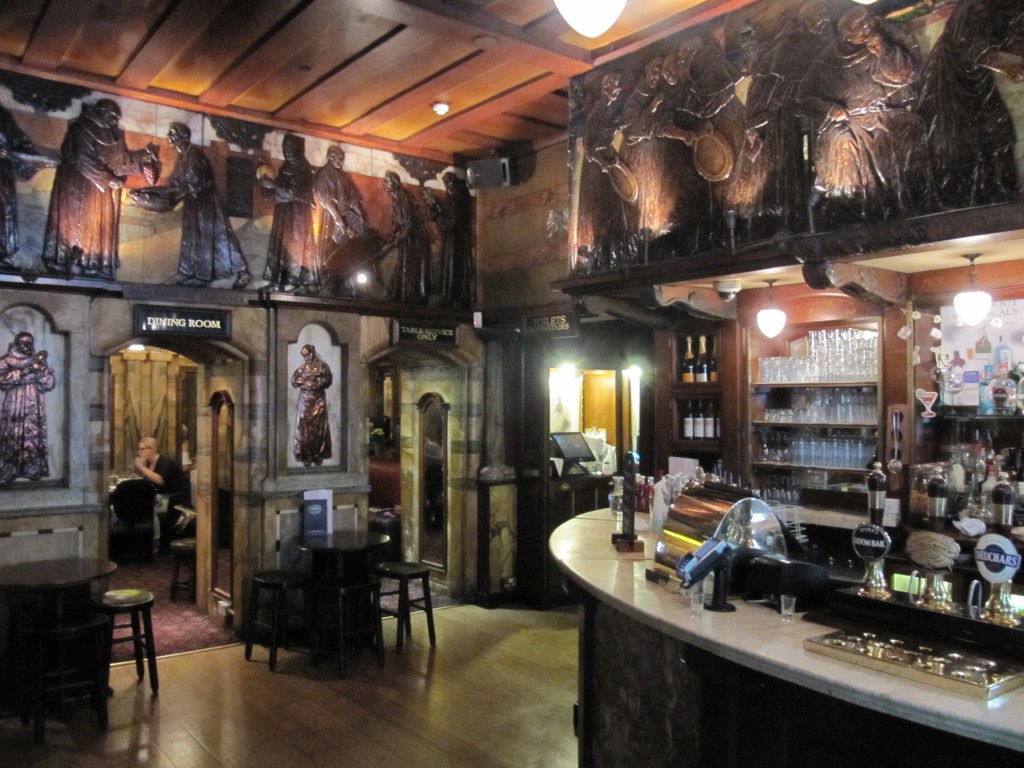
But if you have followed my advice and crossed the bridge to go the the pub, after your pint you can make a detour towards St.Paul’s Cathedral. Leave the pub – I know it’s hard and it’s comfortable in there, but our walk is not over yet, and there are so many interesting things to see – turn left under the railway bridge and immediately turn left again on Blackfriars Lane. Go straight along the short pedestrian Blackfriars Lane and continue on until you cross the narrow Carter Lane, on the right . Continue on Carter Lane and turn left on Creed Lane; at the end of this alley, on your right, you will see the imposing facade of St. Paul’s Cathedral. Follow the road that passes on the right of the cathedral and when you reach the gardens , turn right onto the pedestrian street downhill, that will take you on the Millennium Bridge and, on the other side of the river, to the modern art gallery Tate Modern .
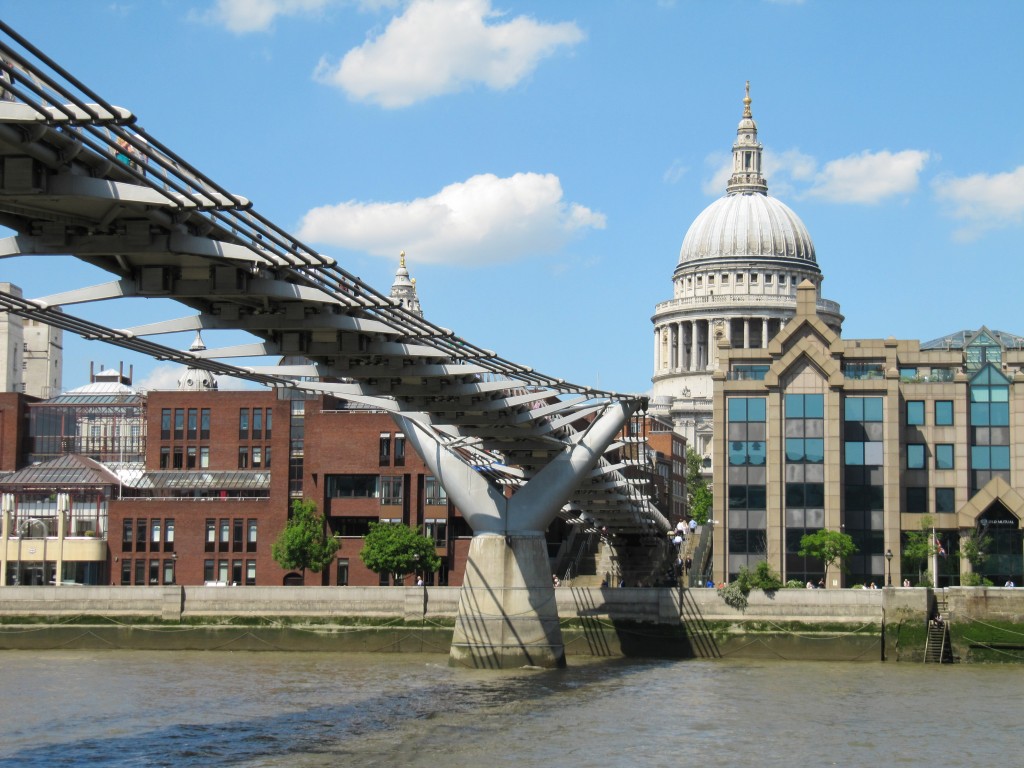
Southwark.
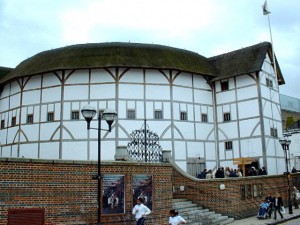
From the Millennium Bridge turn left and follow the path on the south side of the river. It will take you to the Globe Theatre, the reconstruction of Shakespeare’s theatre. We are in the district of Southwark, once a lawless territory. Since it was south of the river, and so technically outside the walls of the city, almost all illegal activities had flourished here since ancient times: prostitution, gambling, taverns of dubious reputation, and even theatres (once considered dens of corruption).
Did you know? The real Globe theatre was built in the late 1500s, and at first it was an open roof theatre, even if the seats were covered (in short, a sort of donut shape). The central uncovered area was for the poorest of the spectators. Shakespeare was also a shareholder in the theatre and had a share of 12.5%, so, when the fame of the theatre grew, even his finances improved. The theatre was destroyed by fire in 1613 and rebuilt the following year. In 1642, with the advent of the Puritans, however, it was closed permanently (like all other theatrs of London, being dens of corruption, as we said before) and in 1644 was converted into housing. The new Globe was built in 1997, very close to its original site.
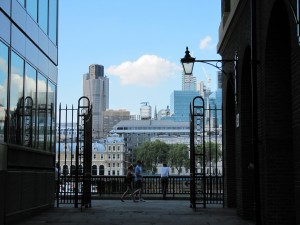
Further along the river path you will see a very transformed area, full of modern buildings. On the other side of the river, you can see the peculiar skyline of the City. At the end of the walkway you reach Southwark Bridge. You can continue on the footpath using the underpass. Follow the road that goeas around The Anchor Pub and then go left under the arch in Clink Street. Here you see the Clink museum, on the site of one of the most famous prisons of London. Another curiosity: this area of Southwark was the so-called Liberty of the Clink, a territory that belonged neither to London nor to the county of Surrey, but was under the jurisdiction of the Bishop of Winchester since 1100. For this particualr status here were permitted activities that were not allowed elsewhere: for example, in 1161 the bishop had obtained permission to allow prostitution, so that prostitutes were nicknamed Winchester Geese. Strange request for a bishop!

Continuing straight on Clink Street we can see the remains of Winchester Palace, the London residence of the Bishop of Winchester. Now we come out onto a small square occupied by the Golden Hinde II, the ship of Sir Francis Drake, the English sailor and adventurer of the sixteenth century. You can read more about his travels on this site.
We simply remember that Francis Drake was the first English sailor to circumnavigate the globe and was made a baronet by Queen Elizabeth I as a reward for the treasures and loots that he had obtained during his travels (or raids, as the previous owners of these treasures would call them). Do not forget that these were the days when England and Spain fought for dominion over the seas, and everything was allowed to win the war, even pirates. Drake was also the main architect of the defeat of the Spanish fleet, the so-called Invincible Armada. Sir Francis Drake died during his last “mission” near Panama, and his body was buried at sea in a lead coffin, which has never been found. Divers and treasure hunters still seek it.
We continue our walk a little away from the river side. After the ship we find ourselves in front of Southwark Cathedral.

Did you know? Sothwark Cathedral, completed in 1273, was one of the first churches built in the Gothic style in London . The structure is still based on the original design , but the church has undergone numerous transformations over the centuries (the aisle, for example , is nineteenth century). Under the reign of Henry VIII became the property of the British crown , and rented for its use. But in 1611 the local merchants (who no longer wanted to pay a rent to use the church) bought the building from King James I for £ 800 (which today could be worth about £ 150,000)
London Bridge
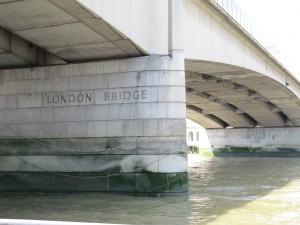 Turning around the cathedral and passing under the bridge we face the Shard; Borough Market and London Bridge are on our left.
Turning around the cathedral and passing under the bridge we face the Shard; Borough Market and London Bridge are on our left.
Borough Market is one of the most famous food markets in London, a real mecca for lovers of cuisines from around the world. The market, already active in the Middle Ages, it was primarily a wholesale fruit and vegetables market, like the famous Covent Garden market. Over time, however, it became a food market intended for an audience increasingly demanding and looking for quality produce. Unfortunately, the market today has become very expensive, and although it is quite nice to visit, you have to look carefully for special offers, if you do not want to pay a fortune. Still, it has a nice atmosphere. The whole neighborhood around London Bridge is quite lively and hectic and much less touristy than the area we have passed along the river.
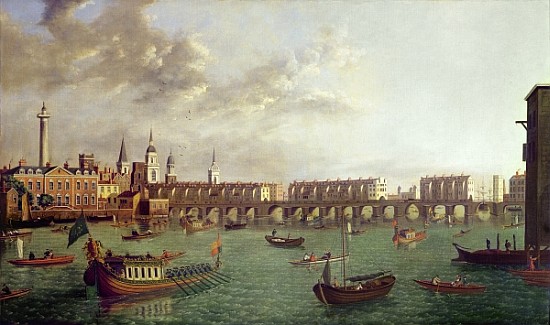
Did you know? London Bridge is the first bridge built over the River Thames and was also the only one until 1729, when Putney Bridge was built, between Fulham and Putney. The original bridge built by the Romans around the year 50 AD stood at almost the same point of the current one. In the twelfth century the first stone bridge was built; its piers caused so much turmoil in the river, that the boats coming upstream had to be pulled aground and carried by hand over the bridge to resume their journey. The bridge had a door at each end and in the middle ages on the Southwark door were displayed the severed heads of the traitors. The first was the famous Scottish rebel William Wallace (immortalized in the movie Braveheart). Being the only entrance to the city of London, London Bridge was also a centre of trade, and real stores came to occupy so much of the bridge that the movement of people and carts became increasingly difficult. To bring back some order in the flow of traffic, a specific regulation was introduced on the bridge, forcing those who entered the city to hold the west side (that is, the left), and the eastern side (the right) for those who came out of it. The current bridge was built between 1967 and 1972, and opened by Queen Elizabeth II on Mar. 17, 1973.
We continue our walk leaving London Bridge on our left, and following the path on the bank of the river. Here the route becomes less interesting for a short stretch, but on the other side we can see several modern buildings of the City, including the unmistakable Swiss Re building, nicknamed “the Gherkin” because of its shape.
We walk along a cover path for a while, then we come out to a wider and nice promenade. Further down we can see the warship HMS Belfast.
Did you know? HMS Belfast was a warship active in World War II; she also took part to the Normandy landings . Later it was used in the Korean War. In 1971 she risked dismantling, but was rescued and turned into a museum. Today you can visit ( ticket for adults costs £ 16) and you can see what life was like on board. More information can be found here .
Tower Bridge and the Tower of London
We are almost at the end of our walk. Behind the HMS Belfast , we can see the unique profile of Tower Bridge .
Did you know? In the nineteenth century, with the growth of trade, the London Docks were growing exponentially, and more than a million people lived in the area east of London Bridge. It was therefore necessary to add another bridge to reduce the traffic on London Bridge. But the docks had to be reached by the sailing ships , therefore a traditional bridge would be an obstacle. Since it was unthinkable to build a fixed bridge, because of the height necessary to permit the sailing ships to pass underneath, all that remained was a movable bridge. If we look at all the designs of more than 50 projects presented, we can definitely say that the most beautiful one has been chosen! Since 1982, the elevated walkway has become an exhibition of Tower Bridge and its construction. A stretch of the walkway has a glass bottom and allows a spectacular view. Admission to the exhibition costs £ 9 and tickets can be purchased here.
Tower bridge glass floor
We cross the beautiful bridge and on the other side we reach the final destination of our walk: the Tower of London.
About the Tower of London there would be thousands of stories to tell and a book would not be enough to collect them all. There is no shortage of anecdotes about the Tower, and it would be all the more interesting to hear them directly from the Yeomen, the sentinels with the colorful uniforms who guard the tower by night and guide the tourists by day.
We only need to remember a few facts:
- the Tower was never meant to be a prison, but it is best known to the public for this. Built by William the Conqueror, the first Tower was a royal palace and a fortress built to protect the city. In fact, it is still a royal residence: the Queen (or King) has the right to reside in a house called The Queen’s House (or The King’s House, when the monarch of the moment is a man).
- Everyone knows that in the Tower of London are preserved the Queen’s jewels. Few perhaps imagine that their estimated value exceeds 20 billion pounds.
- The Tower of London is famous also for the executions, but actually “only” 22 have been carried out within the Tower. The last beheading took place in 1747 and the last execution was in 1941: the shooting of a German spy.
- The Tower of London was also home to an incredible number of exotic animals (today only the statues in the garden remain). Lord Wellington in 1835 decided to remove the animals from the Tower of London, and to bring them to a more suitable place, and so began the London Zoo.
- The stone used to build the White Tower was imported from France (Caen stone).
- Every night at 10 the Tower is officially closed and the closing ceremony (which is definitely worth attending) is considered the oldest military ceremony in the world.
Of course the Tower of London can be visited (it costs £24.50), but after our walk maybe we can just look at the outside, at least for the moment. A good visit to the Tower of London takes at least 2/3 hours, so, if we have been walking enough, we can always come back another time, maybe by bus!
Speaking of buses, since I don’t think you would like to walk back, I suggest you take the bus 15, which offers a very pleasant and comfortable tour through the City. The bus 15 can be taken at the bus stop TA, as indicated in the map below.
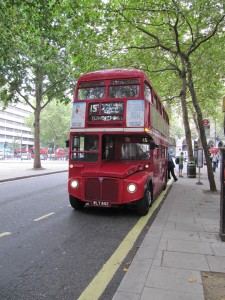 The line 15 is often served by the old Routemaster bus, one of the few old buses still in service. Getting on one of those makes our ride back even more enjoyable, especially if you seat on the top deck. Half way you can stop at St. Paul’s Cathedral, if you have not made the detour to the pub that I advised, but there is a nice view of the Church from the bus too. The visit of the church is not free, but if you are near the time for Evensong (17 from Monday to Saturday and 15 on Sunday ), you can attend the service for free . Of course you cannot wander around the church, but you can still see it inside.
The line 15 is often served by the old Routemaster bus, one of the few old buses still in service. Getting on one of those makes our ride back even more enjoyable, especially if you seat on the top deck. Half way you can stop at St. Paul’s Cathedral, if you have not made the detour to the pub that I advised, but there is a nice view of the Church from the bus too. The visit of the church is not free, but if you are near the time for Evensong (17 from Monday to Saturday and 15 on Sunday ), you can attend the service for free . Of course you cannot wander around the church, but you can still see it inside.
Following the line of the bus 15 you can also see:
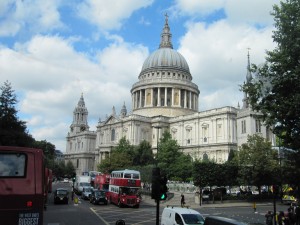
- the City, the financial heart of London, with its narrow road, historical buildings and modern skyscrapers.
- After the Ludgate Circus stop, the bus will take you along Fleet Street – which was the street of the national newspapers until the 80’s – where you can still see some historical places, such as the Punch Tavern (where the satyrical paper Punch was founded).
- Further down the road on your right (after the bus stop Shoe Lane) there is the famous Ye Olde Cheshire Cheese Pub, where Charles Dickens used to stop for a drink when he was working as a journalist in Fleet Street. The pub was re-built after the Great Fire of 1666 and it has kept the typical interiors of an historical Inn.
- After the bus stop Chancery Lane you can see the Royal Courts of Justice (on the right), and on the opposite side (on your left) the historical Twinings shop.
- On the Strand, just after the bus stop Aldwych-Somerset House, you can see the entrance of the magnificent Somerset House, and after Savoy Street, the Hotel Savoy and the Savoy theatre.
Our tour ends at Charing Cross Station, at a short distance from Trafalgar Square.
Did you like our walk? Have you enjoyed the bus ride? What did you like most?
Don’t forget to leave your comments and your suggestions!
